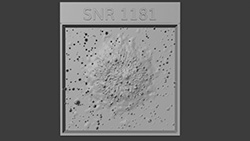1
X-ray, Optical, & Infrared Images of SNR 1181Credit: X-ray: (Chandra) NASA/CXC/U. Manitoba/C. Treyturik, (XMM-Newton) ESA/C. Treyturik; Optical: (Pan-STARRS) NOIRLab/MDM/Dartmouth/R. Fesen; Infrared: (WISE) NASA/JPL/Caltech/; Image Processing: Univ. of Manitoba/Gilles Ferrand and Jayanne English
These images of the supernova remnant known as Pa 30 show X-rays from Chandra and XMM-Newton. The Chandra data pinpoint the central source. The image also contains infrared data from the WISE telescope as well as sulfur seen in a specific band of visible light from the MDM Observatory in Arizona and stars in the field of view from the Pan-STARRS telescope in Hawaii. Astronomers studying this supernova remnant think it is the result of an unusual type of supernova explosion caused by two white dwarf stars merging. Typically no remnant is left behind, but Pa 30 appears to be an example where the result of the merger was not destroyed.
2
3D Printable Files: SNR 1181(3D Print Credit: NASA/CXC/A. Jubett, using software by Tactile Universe/N. Bonne & C. Krawczyk & Blender)
This tactile plate of SN 1181 is a physical relief map based on the intensity of X-ray, optical and infrared data, depicting the remains of a star that exploded hundreds of years ago.
A spherical nebula sits like a puffy dandelion in the middle of the plate, surrounded by a field of stars represented by raised dots. In the center of the nebula is a small point — a neutron star that was left behind after the stellar explosion. From this single point of light, several spectacular rays expand outward like a single firework bursting in celebration in the night sky.
A spherical nebula sits like a puffy dandelion in the middle of the plate, surrounded by a field of stars represented by raised dots. In the center of the nebula is a small point — a neutron star that was left behind after the stellar explosion. From this single point of light, several spectacular rays expand outward like a single firework bursting in celebration in the night sky.
Return to: Stunning Echo of 800-year-old Explosion (March 27, 2024)







